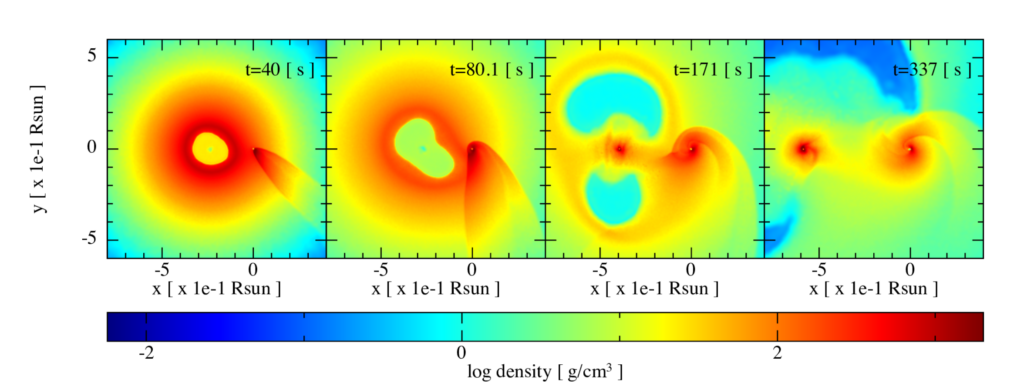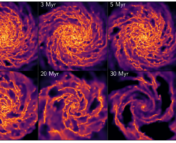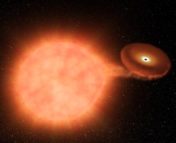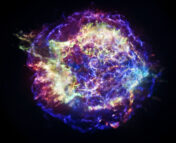Title:The first minutes of a binary-driven hypernova
Authors: L. M. Becerra, R. Moradi, J. A. Rueda, R. Ruffini, Y. Wang
First Author’s Institution: ICRANet, Italy / Escuela de F ́ısica, Universidad Industrial de Santander, Colombia
Status: pre-print available on the ArXiv
A supernova explosion is so dense, so powerful, that it punches a hole through spacetime in the formation of a black hole. Equally as dastardly, a neutron star (NS) can form instead of a black hole (BH) if the dying star does not have enough mass. The dense surroundings of a compact object forming in a supernova are so chaotic that even neutrinos, particles that hardly interact at all, struggle to break free. One of the first signs of life from the inside of a supernova is the gasp of high energy photons, such as gamma ray bursts — an energetic phenomenon of puzzling origin.
The authors of today’s paper simulate in impeccable detail the first few minutes of a binary-driven hypernova (the brighter cousin of a supernova) while paying close attention to how the dynamics affect the companion neutron star. They predict several observables from the process, including what has been observed in the gamma ray burst event GRB 190829A.
A Blinding Light
Much is unknown surrounding the birth and behavior of neutron stars. This is particularly because astronomers do not know how the neutron star equation of state behaves, or the laws governing the phases of neutron star matter. This is crucial to understand where the tipping point occurs between a black hole and a neutron star. In other words, astronomers do not yet know the “maximum capacity” of a neutron star before it can no longer sustain itself against gravity and becomes a black hole.
A useful measurement would be to watch the black hole or neutron star as it’s born in a supernova, but the supernova environment itself is far too dense to observe the birth directly. And so, observers must wait for the shortest wavelength and highest energy signals to escape the debris first, such as a long gamma ray burst. In fact, Long GRBS (LGRBs, or gamma ray bursts that last more the 2 seconds) have been associated with supernovae Type Ic-BL, a specific supernova sub-type associated with a star that has lost much of its hydrogen and helium envelope to its surroundings, and is essentially naked at the time it explodes.
Typically, LGRBs have been thought to originate in a single star collapsing and forming an accretion disk. Today’s authors explore the possibility that instead a binary system powers the emission.
Follow Each Other into the Dark
The model of a binary was appealing to the authors because of the connection between LGRBs and Ic-BL supernovae— it is theorized that Ic-BL supernovae come from stars that lost their material during interaction with a binary companion. In this case, the primary star expands its radius as it evolves, and the companion sweeps away all that puffed out material. For this to work, the orbits of the two stars would need to be rather close, and therefore have a short period.
In the simulation performed by the authors, a star that has been stripped to a carbon-oxygen core is orbited by a neutron star companion. The unraveling of their fates are captured in time steps in Figure 1. The primary stripped star collapses its core into a newborn neutron star (abbreviated νNS… go ahead, say it out loud!) and ejects its outer layers as a supernova. However, the pre-existing neutron star companion is so nearby that it accretes these outer layers, most apparent in the third panel. Here, you can start to see the formation of accretion disks around both dead stars!

If the neutron star companion is very close to the exploding star, it will accrete so much material the it will likely become a rotating black hole (the authors call this BdHN I, or binary-driven hypernova I in the paper). Should the NS begin slightly farther away, it is more likely the NS does not accrete enough matter, but instead grows in mass and sustains a fast rotation (BdHN II in the paper).
Observing the Unseen
To reveal what is hidden in the fiery pit of a supernova, the authors calculate and numerically simulate the system in great detail, keeping track of angular momentum and general relativistic effects while operating in 3 dimensions. The authors use these models to predict observable parameters that will verify the existence of an underlying binary.
One of the telltale signs of a binary origin, they postulate based on their simulations, would be a double-peaked GRB due to the accretion onto both neutron stars (the new-NS and the pre-existing one). This has been observed in GRB 190829A, which the authors conclude is a case BdHNe II: the double-peak structure in gamma-ray radiation is due to accretion process onto the νNS and the NS companion.
Another aspect of their simulation is the inclusion of magnetic fields, often too computationally expensive to consider in detailed simulations. Much is unknown about the role of magnetic fields for this reason– often models must make simplifying assumptions at the expense of simulating out to later times. To illustrate varying configurations and strengths of the magnetic fields (the jargon for this is called “dipole and quadrupole radiation”) the authors created Figure 2.
This figure tells the story of both neutron stars, the νNS (left panel) and the NS companion (right panel). As you read along each x-axis, time increases. In the νNS, accretion causes the star to spin up, increasing its angular momentum (an increase along the y-axis). You can compare this image to Figure 1, when the newborn NS accretes material in the third panel. Then, the magnetic fields of each NS causes them to brake, beginning the “spindown” phase you see just before 10^1[min] in the left panel and all throughout the right panel. The authors determine that neutron stars beginning in close orbits reach higher rotational speeds due to the increased accretion on the NS companion. So, it stands to reason that BdHNe I are faster rotators than BdHNe II where the NSs are farther apart.

With their detailed, long-duration simulations, the authors provide unique insight into otherwise hidden aspects of the explosion, tackling three large mysteries at once: the neutron star equation of state, the origin of GRBs, and the progenitor systems behind Ic-BL supernovae. Further studies of νNSs, particularly the peaks in their gamma-ray emission will uncover how massive stars reanimate after their deaths.
Astrobite edited by Mark Popinchalk
Featured image credit: istockphoto.com and Etsy seller DarkVisionArts




